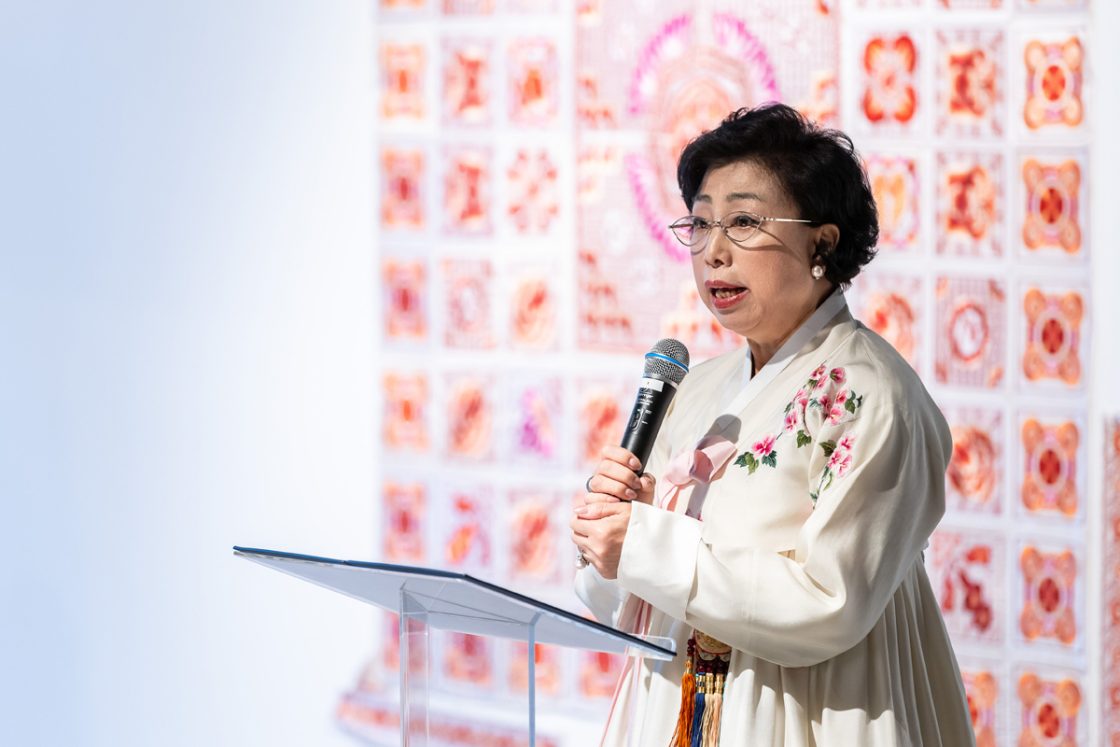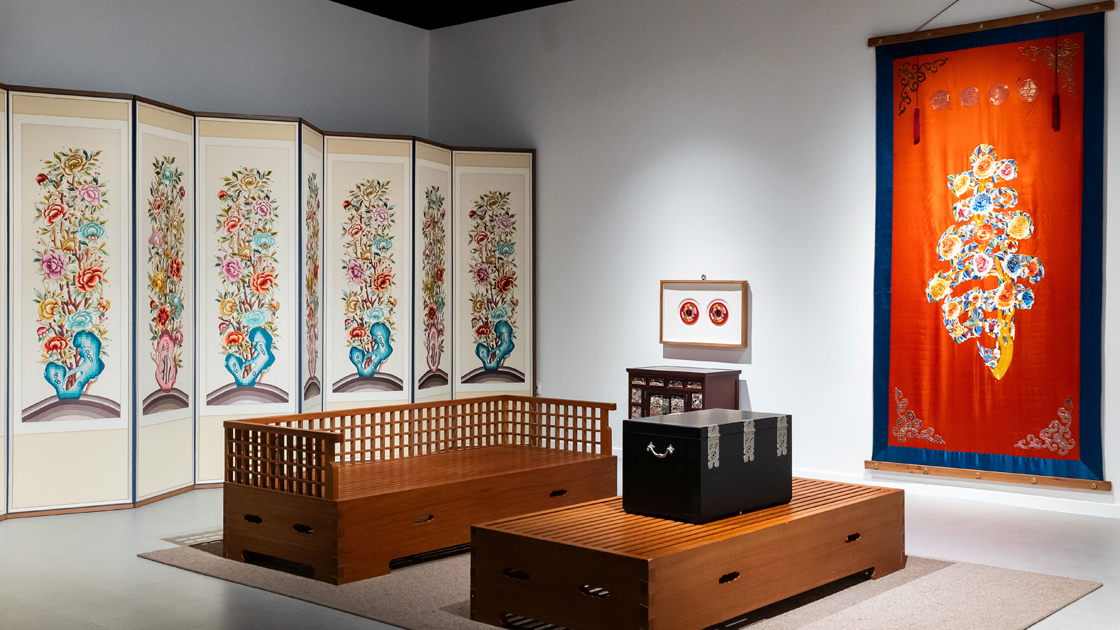
The Korean Cultural Center in the Hungarian capital presents the ROYAL PALACE exhibition, the symbolic title of which evokes the history and artistic value of Korean embroidery. It features works by Lee Jungsook that reinterpret court embroidery from the Joseon period. Through them, the uniquely subtle beauty and deep cultural significance of Korean embroidery is revealed.
What at first glance appear to visitors to the exhibition to be beautiful pictures are in fact entirely handmade, traditional Korean embroidery works. The artist Lee Jungsook was fascinated by this activity from an early age.
"I first got my inspiration from my mom, she was the one who introduced me to a little bit of everything, whether it was the use of colors or technique. I did it as a hobby at first, and then I was taught by a master who introduced me to it more and gave me deeper technical knowledge about this art. Then, I had a couple of exhibitions and I realized that I should show the public, whether it was the Korean or the foreign public, how I could show the representative, real, traditional lines of Korea in this," the artist tells Diplomacy&Trade.
Joseon period embroidery
For more than 500 years, the Joseon Dynasty (1392-1897) defined Korea’s social, political, and cultural development. This period saw the establishment of Confucianism as the dominant ideology, influencing every aspect of life, including the arts and crafts. Embroidery flourished during this time, becoming both an artistic expression and a symbol of power and status. Of course, embroidery changed over these centuries. As Lee Jungsook explains, “in the beginning, it was more typical – obviously we are talking about the upper classes here – that women made embroidered clothes for their husbands, to make their clothes as ornate and beautiful as possible, so that was the focus. Then it got to a point where it was getting too ornate, and so, there was a systematic redesign, and one of the points of that was to separate those who were military officials from those who were more of the artistic or literary officials, and they had different symbols. For example, the military strata used the tiger motif, which was frequent, while for the clerks, it was a bird symbol, which they could use. Then, towards the end of this Joseon dynasty, there was another such redesign towards state officials. So, there were some minor or major changes in the symbolism itself and in the decoration itself over this period.”
Colors and motifs
It was this Joseon court embroidery that has been reinterpreted by Lee Jungsook. “This traditional early embroidery used obangsaek, the color scheme of the five Korean traditional colors of white, black, blue, red and yellow, but modern people today think that these five colors of the obangsaek are obsolete. Therefore, one of the main points of this reinterpretation was to make these traditional colors a little more accessible to a modern audience. You can see that even though these five colors remain, sometimes a different shade of something else creeps in, so that the modern audience can understand it or can come to it as understandable material,” the artist says.
The main motif in these embroideries is the flower. Pointing at one of her works, a screen with lotus flower images (see pictured) used in the women's room, she adds that “the lotus flower, which we see a lot in these works, has a symbolic meaning, it expresses happiness and peace.”
In other works of hers displayed one see animals that also have symbolic meaning. “They all symbolize long life, that is, aging well, calm, peaceful aging.”
Bojagi
The bojagi or Korean wrapping cloth, is far more than a simple textile for carrying or protecting objects. It symbolizes luck, harmony, and aesthetic perfection. The exhibition highlights this unique craft, which played a crucial role in both daily life and ceremonial events.
As the artist highlights, it has two meanings: “one is obviously practicality, which means that you can wrap something in such a material, and the pronunciation is similar to the Korean word for luck (bok), so it has a figurative meaning, a philosophical meaning, that the user embraces luck and wraps things up to have luck. It was present in women's everyday lives, an everyday object, that is why I chose bojagi as such a central theme, it is what is closest to people – something with philosophy and practicality. Showing how representative the bojagis are of Korea, I can mention that, for example, the Korean president, back in 2015, gave these as gifts to various ambassadors and even once to the Portuguese president.”
Traditions and modernity
Lee Jungsook’s art is a combination of Korean folk traditions and modernity. “You could say that the basis of my work is the traditional lineage, and I think about that in an approachable way for the modern person to think about what that means,” she says. Pointing to a dress, she adds that “it was basically a completely traditional outfit and I put modern elements into it. Or, what you can see on the back is a Buddhist painting – now, we call it a painting as originally, I had the painting and I embroidered modern touches into it to transform it into a more consumable product for the modern person as a final result.”
Korean embroidery worldwide
Budapest, where the works are on display till early July, is just one of the exhibition venues worldwide. “I have been to many countries as an exhibitor, mostly Japan but I usually go once or twice a year to Paris, France. I have also been to the Netherlands, then Frankfurt-am-Main in Germany, and even to the United States as exhibitor. In the future, I would like to go to the Middle East, either to Saudi Arabia or to other countries in that region, where I hope to have the opportunity to exhibit. I have also received an invitation from UNESCO, and thus, we are planning to take this exhibition to New York City and then to the Vatican Museum as well,” she points out.
Audience reaction as motivation
So, Lee Jungsook travels a lot internationally and it is interesting what sort of reactions she receives from the public, from people who are encountering something like this for the first time. “I meet a very diverse audience, with very colorful reactions. I was invited by the French state to Art Capital, the iconic event at the Grand Palais in Paris, and I saw that French visitors would stop for several minutes or longer in front of an exhibited item and cry. When you see something like that, it gives you a kind of motivation. So, that gave me the idea of organizing more exhibitions, coming back with even better products. So, for me, the reaction of the viewers becomes an absolute motivation. I really wanted to have an exhibition here in Hungary and here again, I see that people look at my works with a lot of attention – that is an extra motivation for me,” she concludes.


Leave a Reply Cancel reply
Top 5 Articles
 Shaping a Generation of Creative and Resilient… September 10, 2025
Shaping a Generation of Creative and Resilient… September 10, 2025  For the Export Success of Hungarian Enterprises June 17, 2025
For the Export Success of Hungarian Enterprises June 17, 2025  Hungary, a World Leader in Solar Energy April 8, 2025
Hungary, a World Leader in Solar Energy April 8, 2025  MEPs call for EU court action after Hungary passes… April 18, 2025
MEPs call for EU court action after Hungary passes… April 18, 2025  Hungary Rejects Calls to Cease Russian Oil Imports September 26, 2025
Hungary Rejects Calls to Cease Russian Oil Imports September 26, 2025






No comment yet. Be the first!